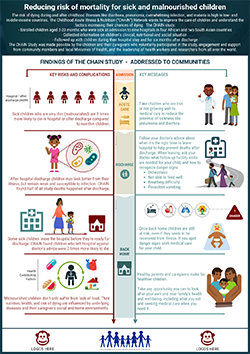The thought of developing a communication poster can be overwhelming or create mixed feelings.
You may have experience communicating your research visually or are unsure where to start.
To ease the process, this section will walk you through the three phases needed to develop a communication poster. We will do so, using clear examples of how this was implemented with The Childhood Acute Illness and Nutrition Network (CHAIN) consortia whilst they created their communication posters.
CHAIN is a group of clinical experts, scientists, and advisors worldwide seeking to optimize care for vulnerable children in limited-resource settings. The principle behind the CHAIN Network is that an episode of illness occurs within the child’s ‘health trajectory’. Low birth weight, frequent infections with too little time between each episode to fully recover, suboptimal feeding, and socio-economic constraints result in ongoing risks of mortality and poor growth despite treatment. To find out what aspects of these could be addressed to improve outcomes, the CHAIN Network has initially been conducting a multicentre harmonized cohort study. To identify potential improvements in current treatment policies in hospitals, in communities and improve the linkage between the two, the CHAIN Network has shared its results with the community, healthcare workers, and policymakers through online webinars, and through the creation of Research Communication Posters for all three audiences.
Now that you know about the benefits and background of Research Communication Posters,
|

